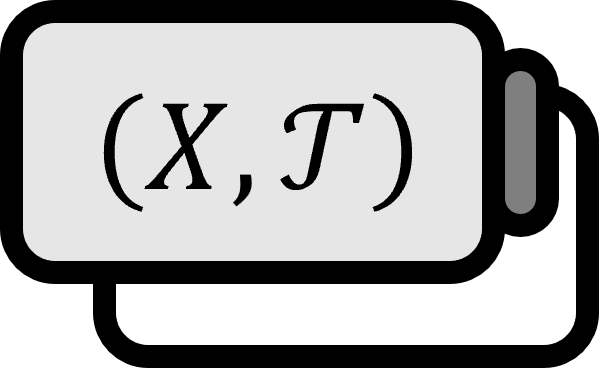Path-Connectedness in Topology
Definitions 1
Let’s call $X$ a topological space and let $C \subset \mathbb{R}^{n}$.
- A continuous function $p : [0,1] \to X$ from initial point $p(0)$ to terminal point $p(1)$ is called a path. $\overline{p}(t) = p(1-t)$ is called the reverse path of $p$.
- If for every $a,b \in X$ there exists a path $p$ satisfying both $p(0) = a$ and $p(1) = b$, then $X$ is called a path-connected space.
- For all $a,b \in C$ and $t \in [0,1]$, if $(1-t) a + t b \in C$ then it’s called convex.
- If $p(0) = p(1)$ then it’s called a closed path.
Explanation
Simply put, if there is always a path connecting any two points of a space, it is called path-connected.
- $X$ is a disconnected space since there exists a continuous function $f : X \to \left\{ a, b \right\}$.
- $X$ is a path-connected space since there exists a continuous function $p : [0,1] \to X$.
Thinking in terms of whether there is a continuous function satisfying certain conditions makes it easier to distinguish between disconnected and path-connected spaces. However, it is important to note that many details are omitted in the above statements, so they should not be taken as is.
Convexity
The concept of convexity doesn’t necessarily need to be defined only in subsets of Euclidean spaces, but can also be defined in subspaces of vector spaces. Geometrically speaking, a set is convex if a straight line connecting any two points always exists within the set.

For example, looking at the two shapes above, the blue circle is convex because any two points can be connected by a straight line. The orange shape is not convex because there is no straight line that can connect points $a$ and $b$ inside it.
Connectivity
Upon closer inspection of the definition of a path-connected space, it almost seems identical to a connected space. Indeed, the following theorem is not difficult to prove, and distinguishing between the two might seem meaningless. However, connectivity and path connectivity are distinctly different concepts because there exist counterexamples where the inverse of the theorem does not hold. Convex subspaces or open connected subspaces are examples where the inverse does hold.
Theorem: If a space is path-connected, it is connected.
Proof
For a path-connected space $X$, if $X = \emptyset$ then $X$ is a connected space. If $X \ne \emptyset$, then we can choose some point $a \in X$. Then, for any $x \in X$, there exists a continuous function $p_{x} : [0,1] \to X$ satisfying $p_{x} (0) = a$,$p_{x} (1) = x$.
The continuous image of a connected space is connected For a connected space $X$, if $f : X \to Y$ is a continuous function, then $f(X)$ is a connected space.
Since $[0,1]$ is connected, $p_{x} ( [0,1] )$ is connected, and since $\displaystyle a \in \bigcap_{x \in X} p_{x} ( [0, 1] )$, therefore $\displaystyle \bigcap_{x \in X} p_{x} ( [0, 1] ) \ne \emptyset$
(3) The set of connected subsets of $X$ $\left\{ A_{\alpha} \ | \ \alpha \in \forall \right\}$, if $\displaystyle \bigcap_{\alpha \in \forall} A_{\alpha} \ne \emptyset$ then $\displaystyle \bigcup_{\alpha \in \forall} A_{\alpha}$ is a connected space.
Therefore, $\displaystyle X = \bigcup_{x \in X} p_{x} ( [0, 1] )$ is a connected space.
■
See also
Munkres. (2000). Topology(2nd Edition): p155. ↩︎
